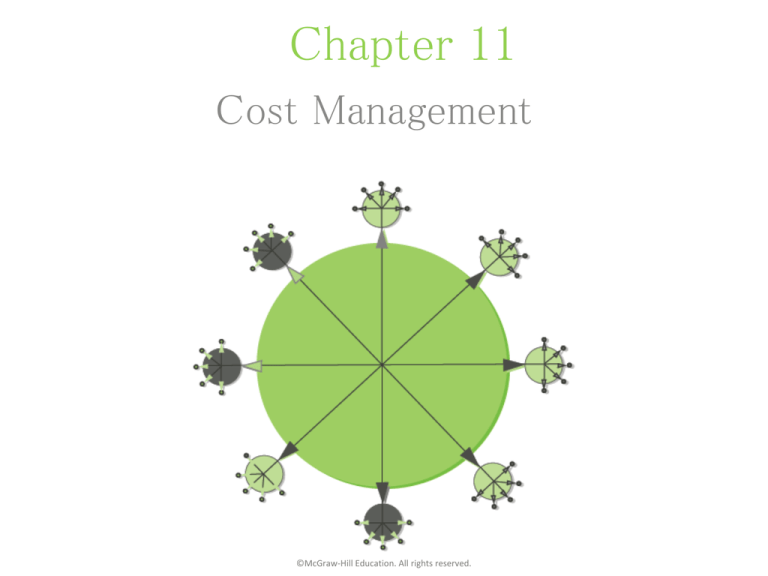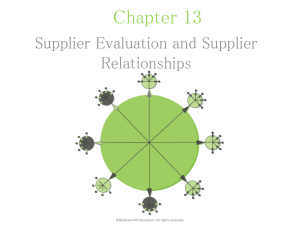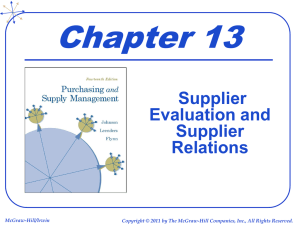
Chapter 11
Cost Management
©McGraw-Hill Education. All rights reserved.
Key Questions Addressed in
Chapter 11
• How can cost management and negotiation
tools help identify opportunities and assure
value?
• How can we determine
– the supplier’s costs?
– deliverer’s cost?
– our own use costs?
– disposal costs?
Strategic Cost Management
• An externally focused process of analyzing
costs in terms of the overall value chain
–
–
–
–
–
A continuous improvement process
Measure and improve specific cost elements
Tools and techniques to sustain cost savings year over year
Strategic partnering to achieve competitive advantage
An opportunity for strong supply leadership to develop a cost
culture rather than a price culture with multiple internal
stakeholders and suppliers
ABC or Pareto Analysis
and Cost Management
• Assign items to A (high-dollar), B (mediumdollar), or C (low-dollar) category
• A items = greatest percent of annual spend
• Cost management approach for A items:
– More time and managerial attention
– Understand supplier’s cost structure
– Identify opportunities for supplier or joint buyersupplier initiative to eliminate, reduce, or avoid costs
in any cost elements (materials, services, labor, and
overhead)
Portfolio Analysis
High
strategic
items
non-critical
items
leverage
items
Risk
bottleneck
items
Low
High
Low
Value
©McGraw-Hill Education. All rights reserved.
5
Major Categories for the Components of
Total Cost of Ownership
Total Cost of Ownership
Pretransaction Components
• Identifying need
• Investigating sources
• Qualifying sources
• Adding supplier to internal
systems
• Educating:
– Supplier ins firm’s
operations
– Firm in supplier’s
operations
Transaction Components
● Price
● Order
placement/preparation
● Delivery/transportation
● Tariffs/duties
● Billing/payment
● Inspection
● Return of parts
● Follow-up and correction
Posttransaction Components
● Line fallout
● Defective finished goods
rejected before sale
● Field failures
● Repair/replacement in field
● Customer
goodwill/reputation of firm
● Cost of repair parts
● Cost of maintenance and
repairs
Source: Lisa Ellram, “Total Cost of Ownership: Elements and Implementation,” International Journal of Purchasing
and Materials Management, Winter 1993.
©McGraw-Hill Education. All rights reserved.
6
Target Costing Example
> Target Cost
Future Market Price – Desired Profit =
Part/System Price
Current Profit
Adjust for Spec. Differences
Desired Profit
Current
Cost
ModeltoModel
Change
Internal
Costs
C
Target
Cost
B
A
Current Price
Verified By
Cost Standards
Purchased
Component
Part Level
Costs
Component
Target Costs
©McGraw-Hill Education. All rights reserved.
7
Value Expression
• Value can be expressed as:
VALUE = Function
Cost
– Function = a noun-verb combination (e.g., holds
liquid)
Activity Based Costing
• Tries to turn indirect costs into direct costs by
tracking the cost drivers behind indirect costs
• Manufacturing overhead is divided into:
– costs that change in response to unit-level
activities
– batch-level activities
– product-level activities
– the remainder are true fixed costs and are
allocated according to traditional cost accounting
Negotiation
• The most sophisticated and most expensive
means of price determination
• A difficult art requiring judgment and tact
• An attempt to find an agreement that allows
both parties to realize their objectives
• Requires the buyer and supplier, through
discussion, to arrive at a common
understanding on the essentials of an issue












